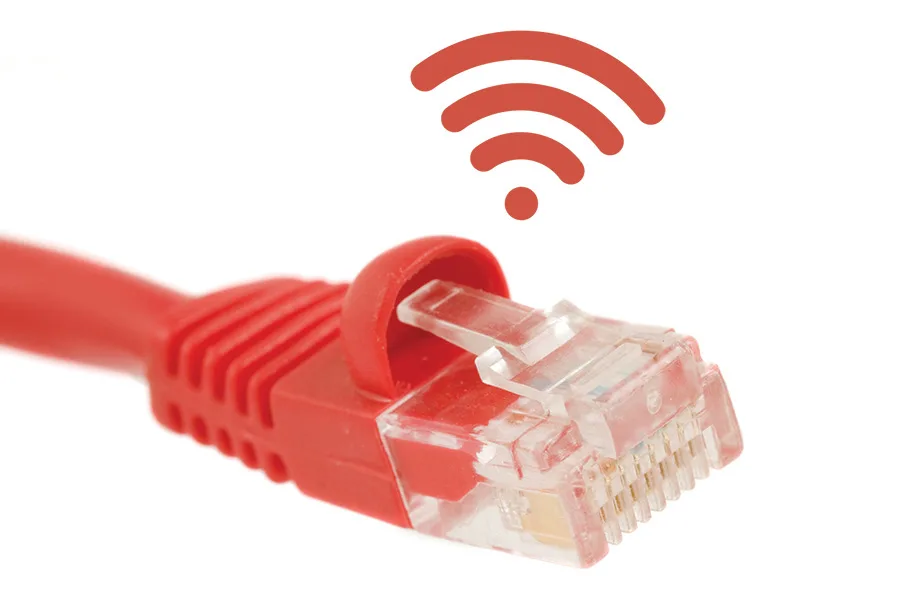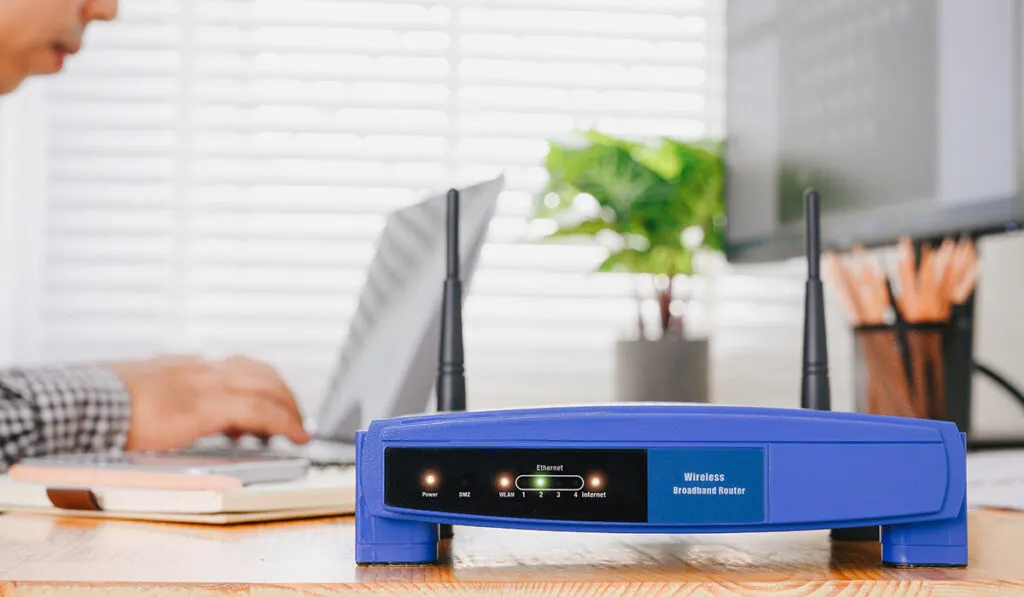If you are having issues with slow internet speed, you might have wondered if using ethernet and Wi-Fi at the same time could improve your connection speed on your laptop or computer. Wi-Fi and ethernet are both effective ways to get the internet to your computer on their own, but can you use both at the same time?
Wi-Fi and ethernet can be used at the same time on your computer, however, the connection will not be any faster than just using one connection type. This is because the data comes from the same source, the same router. So the internet speed is limited by the max speed of the router.
Wi-Fi and ethernet will both provide access to the internet and understanding how they work and what limits the speed will help you decide if you should use Wi-Fi, an ethernet connection, or both combined to get the fastest access to the internet. Get the best internet speed, fast!
How to use Wi-Fi and Ethernet at the Same Time

You can use Wi-Fi and ethernet at the same time is possible on a desktop computer, a laptop that has an ethernet connection and built-in Wi-Fi, or a laptop with an ethernet connection added to it (our guide on how to do this). Depending on the operating system (macOS, Windows, Linux, or Chrome OS), you will need to configure your settings to connect to both the Wi-Fi and the ethernet connection from your router.
An ethernet connection can be established by connecting an ethernet cable from your router to your computer. Once you have the ethernet connection established you will have to enable a simultaneous Wi-Fi connection. By default, your computer will likely only access one connection at a single time.
To use both connections at the same time, you will have to configure special settings to actually download data from both connections at the same time.
Configuring your computer to use both ethernet and Wi-Fi connections at the same time can prove problematic, as the connections could try to talk over one another which will ultimately slow your internet connection down. In this case, attempting to speed up the internet connection just made it slower!
Why Won’t Using Wi-Fi And Ethernet Speed Up Your Internet?
Using both Wi-Fi and ethernet at the same time will not speed up your internet. The reason is that the internet speed is limited by the data speed of the router you are using, the upstream connection speed, or in some cases, even bad weather, like we’ve explained before.
Think of your routers like your garden hose and faucet, if you turn it on all the way the flow rate of the water will be at its fastest rate, let’s say it fills up a gallon bucket in 1 minute.
Now imagine you connect a tee fitting to the end of your hose to divert the flow into 2 separate directions, then turn the faucet on full blast again. If you have both ends of the tee on the hose going into the gallon bucket, it won’t fill it any faster than 1 minute.
This is because your faucet, the upstream device, is now feeding the flow of water to both openings in the tee fitting.
It can’t provide water any faster just because you attached a tee fitting to it. It is still limited by the upstream flow rate of the faucet (which is the same as your router’s upstream connection speed)!
Your router is the bottleneck of your internet speed, connecting to it with 2 different methods- Wi-Fi and ethernet- will do nothing to increase the internet speed. In fact, it will likely slow down the internet speed!
As many who have gone down this route before have learned (forum), the only way to increase your overall network speed, in some cases, is simply to increase the amount of bandwidth you buy from your provider! But for some people, connecting their networks is the right solution, even if it comes with some complications….
How Could Connecting Wi-Fi and Ethernet Together Slow Your Internet?
Connecting to both Wi-Fi and ethernet at the same time can slow your internet speed because the data packets being sent by the router can get mixed up, duplicated, and/or received in the incorrect order on your computer. Your computer won’t be able to process the information correctly and the internet will slow down.
In other words, staying with one connection, ethernet or Wi-Fi, is the best way to optimize your internet speed. If you have an older laptop with an old Wi-Fi chip and/or an older router, you may not be capable of sending or receiving data at the full network speed from your router.
You can get a faster internet connection by plugging in the ethernet cable, however, this is not because it is using both Wi-Fi and ethernet. The internet speed is only quicker now because the data can be transferred faster through the ethernet connection than the Wi-Fi connection, not because the computer is using both connections.
What Software Do You Need to Combine Wi-Fi and Ethernet?

There is special software from Speedify that allows your computer to connect to both Wi-Fi and ethernet at the same time. However, this only works if the ethernet and Wi-Fi are completely separate routers and networks.
Connecting to the same router and same network with both Wi-Fi and ethernet will not allow you to access the internet at a faster speed. Remember, the router is the upstream speed bottleneck.
Using this special software, or one like it, to connect to Wi-Fi and ethernet at the same time that have different routers and different networks can boost your internet speed. However, this type of software works like a VPN; all of your internet traffic has to go through it, so it might slow down the internet speed. It is technically feasible to increase your internet speed with the software. We’ll look more at these ideas as we move through the article, and offer some more software solutions.
Can You Use Two Different Wi-Fi Networks at Once Increase Your Speed?
Maybe if you connect your computer to ethernet through your router in your home and connect your Wi-Fi through (for instance) your neighbor’s router using the special software, you can potentially increase your internet speed.
Don’t let the neighbors know that they have an easily guessed Wi-Fi password just yet! You want to enjoy their internet speed boost for as long as possible! Your computer is limited on how much data it can receive at once. It’s limited on that downstream data flowrate. The speed at which your computer can receive data is the downstream bottleneck for your internet speed.
Even if this did work, you can’t merge two Wi-Fi networks into one SuperNet work because of the way the Wi-Fi protocol works. Some devices called mesh networks can pull this off, but ultimately you will always still be limited by the pipeline from the ISP.
Load Balancing WiFi and Ethernet (aka “Network Bonding”)
By using both connections at the same time, you can distribute network traffic across multiple channels, reducing the load on each connection and improving overall performance. But you have to do this intentionally, through a process called “load balancing.” This is just what it sounds like: balancing the load between the possible routes for network traffic: ethernet vs. Wi-Fi in this case.
There are a few ways to load balance Wi-Fi and Ethernet connections, including using specialized software or configuring your network settings manually. But in general, load balancing, or at least the details (an explainer) can be pretty intimidating. Some routers also come with built-in load balancing features that can help distribute traffic automatically, but if you’re not already good with IT this is a task you probably don’t want to give yourself.
When it comes to network bonding, the idea is pretty similar: you can splice the data streams together in a way that is basically load-balancing by another name. For either of these projects – network bonding or load balancing – there are a variety of tools available that can help you bond your connections, including Speedify, Connectify, and NetBalancer. Again, we don’t recommend going into this particular rabbit hole unless you’re already a pretty tech-savvy person.
Is There Any Priority While Using Ethernet and Wi-Fi Simultaneously?
When using Ethernet and Wi-Fi simultaneously, there is usually no priority between the two connections. Your device will automatically distribute network traffic across both connections based on the load and available bandwidth, or, as mentioned above, if you’re doing intentional load balancing the traffic will be routed wherever it’s been routed by the management software. Here’s an example of how Microsoft PCs running Windows 10 automatically pick which connection to use (forum).
However, some devices may prioritize one connection over the other based on network settings or other factors. For example, if your Ethernet connection is faster and more reliable than your Wi-Fi connection, your device may automatically switch to using Ethernet whenever possible.
This is an important point, because it highlights that even if you hook both connection up, without managing the load balancing, there’s no guarantee that you’re actually optimizing performance past the build-in software (which is probably going to do it very well anyways).
Can Macbooks Connect to Wi-Fi and Ethernet Simultaneously?
Yes, Macbooks can connect to Wi-Fi and Ethernet simultaneously. By using both connections at the same time, you can distribute network traffic across multiple channels, reducing the load on each connection and improving overall performance.
To connect to both Wi-Fi and Ethernet, simply plug in your Ethernet cable and connect to your Wi-Fi network as you normally would. Your Macbook will automatically distribute network traffic across both connections based on the load and available bandwidth.
Conclusion
So, if you’re on the fence, just think about your use case: do you need more Wi-Fi, or more Ethernet connections…and based on this article maybe you’ll reconsider trying to use both of those on the same device at the same time!
